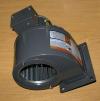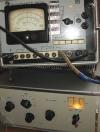This device ATT-DN-B10 is a further development of the board DN-B10. The detailed description of the board DN-B10 you can see by the link => http://www.ut2fw.com/node/469
The device ATT-DN-B10 includes such functions:
1. Automatic Band Decoder (10 bands, controls LPF filters)
2. Sequencer (controls RX-TX relay, BIAS, voltage +12V TX)
3. Controls input attenuators relays
4. Controls protection input amplifier
5. Controls ALC for transceiver
6. Controls change power external amplifier
7. Works complete with DN-AUTO, see link => http://www.ut2fw.com/node/470
8. The connection from the computer to change the settings ATT-DN-B10
The signal from the transceiver supplied to the IN-ATT input. The relay K1 switches the input of the amplifier.
The RX output supplied to the relay, which switches the output of the amplifier (it is a so-called "bypass" of the amplifier).
As a result, in the RX mode the transceiver has connected to the antenna through the contacts IN-ATT – K1 – RX – the power relays of the amplifier output.
When switching the amplifier into the TX mode (the contact PTT is connected to GND) – the input IN-ATT connects to the input of the amplifier through contacts of the relay K1.
The ATT1 with attenuation of 6 dB installed on the input of the board. The ATT1 includes powerful resistors, each on 30W. The ATT1 can withstand up to 100W for a short time. The rated power of the ATT1 is 50W.
Then two more attenuators (ATT2, ATT3) turned on consistently through contacts of the relays K2, K3. You can choose of the four state attenuators at any band:
1.Both ATT off.
2.Turns on ATT No. 1.
3.Turns on ATT No. 2.
4.Turn on both ATT.
State of attenuators are selected on the stage of programming the microprocessor CPU.
In the original program to turn on used next an algorithm:
160m, 80m, 40m, 30m - ATT1 on, ATT2 off.
20m, 17m, 15m, 12m, 10m - ATT2 on, ATT1 off.
6m - both ATT1-ATT2 off.
A powerful shunting resistor R32 makes a protection of the amplifier input.
The protection is fast acting, because the key to MOSFET VT6 provides the connection R32. A voltage of +48V securely holds closed key VT6 to avoid its opening by input power.
The LED VH13 ALARM indicates when the protection turned on.
There are two automatic circuit for monitoring an overload and turning on the R32. The first circuit is analog it is highlighted on the circuit diagram by red components. The second circuit is digitally on the microprocessor CPU.
Resistors R13, R24 are set the upper threshold power for turning on the protection.
Both protection circuit have the "latch". You cannot disable the protection after turning on when the power has reduced until the amplifier has not returned in the RX mode. Thus, if the protection has tripped, you need to switch from TX mode to RX mode.
The protection turned on in the circuit QH7 for the time of switching relays RX-TX – 50ms.
The circuit ALARM_IN performs external control of the protection turning on. For example, by the signal from the comparator SWR-meter of the Out Unit board.
Other functions of the ATT-DN-B10 board correspond to the functions of the DN-B10 board. You can get more details about the DN-B10 by the link => http://www.dn-radio.com/content/dn-b10
Therefore, I will try to speak briefly about them here.
U1, VT16, VT11, 15 provide control signals to the ALC transceiver: the ALC_OUT is a voltage of negative polarity and the ALC+ is a voltage of positive polarity. You can adjust the voltage ALC_OUT (from 0V to -9V) by the resistor R45.
The decoder DD6 controls selection on the 10 bands.
The compliance bands and frequencies described further in the text.
The Decoder/Driver 74LS145D is using as the DD6. The manufacturer of the 74LS145D announce this Decoder/Driver as switching a relay. The quote from the dataset on 74LS145D: «It is designed for use as indicator/relay drivers or as an open-collector logic circuit driver». However, it is not specified anywhere in the description about availability of protective diodes for keys 74LS145D. The performance of the 74LS145D for control of relays in LPF600, LPF1200, and LPF1500 had checked without additional protective diodes. I recommend using shunting of the relay winding with an additional diode to increase reliability.
The PWR signal can be using as a reference voltage to control of the power and protection of the transceiver and amplifier. Read more about this feature further in the text.
The PWM signal disables the operation of DD6, i.e. the Bands Decoder.
BIAS_OUT is the BIAS voltage for the amplifier.
+TX_12V is the +12V TX voltage.
PC, DN-AUTO – The board ATT-DN-B10 can be using in the DN-AUTO complex. The complex DN-AUTO of the three boards: DN-AUTO CPU, Controller Protections, ATT-DN-B10 provides full control of the amplifier protection, output an information on the LCD display, on the monitor of the computer (a program has developed the AmpMonitor for computer),
control of the LPF, antennas and many other features. The detailed description of the DN-AUTO you can read by the link => http://www.dn-radio.com/content/dnauto
The ATT-DN-B10 is able to connect to COM-port of the computer via additional RS232. The computer program, which allows changing CPU settings, has developed.
The VH14 LED indicates the presence and capture of the input frequency by the CPU frequency meter.
Settings of voltage levels of the PWR and input power are changing by the buttons SA1, SA2. These levels are set and stored in the CPU separately for each band. Therefore, you can always adjust the protection (power) settings individually to your amplifier for each band separately.
The resistor R10 adjusts the sensitivity of the CPU frequency meter. The initial setting is on 10W.
A detailed description of the settings ATT-DN-B10 are enclosed on CD to the board.


